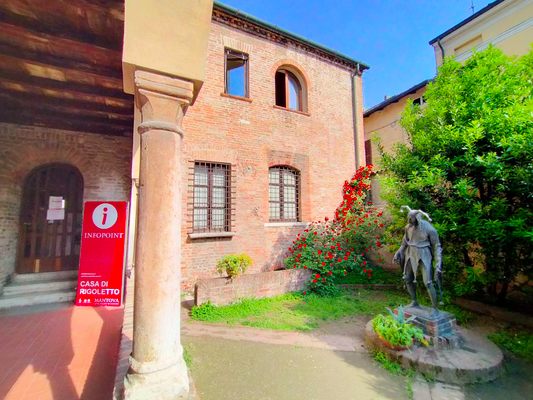About
Mantua is a Renaissance city that was rebuilt over a medieval town. The city is filled with architectural remnants of both of these time periods—sometimes within the same structure. Just behind the cathedral, there is a small 12th-century building embellished with a 14th-century porch and loggia. This building is called Casa del buffone Rigoletto.
If the name doesn't ring a bell, Rigoletto is the hunchback court jester of the Duke of Mantua, who was immortalized in an opera by the Italian composer Giuseppe Verdi. Debuted in 1851, Rigoletto is considered one of Verdi's finest works, along with Il trovatore and La traviata.
The opera tells the story of Rigoletto and his daughter Gilda, who falls in love with the untrustworthy Duke of Mantua and her sacrifice to save his life against some killer sent by Rigoletto himself. It is an adaptation of Victor Hugo's 1832 play Le roi s'amuse (The King Amuses Himself ).
Hugo's play was controversial, specifically in its unflattering depiction of French royalty. After a single performance on November 22, 1832, Le roi s'amuse was banned by a ministerial decree. Nearly two decades later, Verdi was commissioned to compose a new opera. He wanted to adapt Hugo's work for the stage, but had to tread carefully in order to navigate the geopolitical situation. Verdi changed several elements of the story: the setting moved from France to the Duchy of Mantua, and several of the characters were renamed.
This small house in Piazza Sordello is considered to be the model for Rigoletto and Gilda's home in the opera. In 1978, the city of Mantua put a bronze statue of Rigoletto in the house's small garden.
The legend of Rigoletto remains so tied to Mantua that another building, a lakeside medieval tower, is called Sparafucile Tower, after the opera's assassin character.
Related Tags
Know Before You Go
The building is now a tourist information office.
Flavors of Italy: Roman Carbonara, Florentine Steak & Venetian Cocktails
Savor local cuisine across Rome, Florence & Venice.
Book NowPublished
June 15, 2022








































